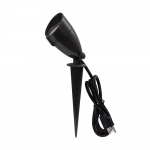Jerramundi
Senior Member
- Location
- Chicago
- Occupation
- Licensed Residential Electrician
Just perusing some light fixtures and the following occurred to me. Just wondering if my instincts are on point or not...
Tough to see here, but the cable for this fixture exits the back at an above grade location.
It's my understanding, whether low voltage or line voltage, that this would be in violation of 300.5(A) Min. Cover Requirements and 300.5(D)(1) Emerging from Grade.
Now there's an interesting Note under Table 300.5 (i.e. Note #3) which roughly states that "lesser depths" shall be permitted when rising for "terminations or splices." I interpret this as the cable could rise to a "lesser depth" to terminate at the fixture, but NOT "zero depth." In other words, the cable could rise to "terminate" at the bottom of the fixture, as long as some degree of burial is maintained.
Another thing that caught my attention was that this product is ETL listed, which makes me want to ask, and I should probably know the answer to this, but do NRTL listings guarantee NEC compliance? I'm thinking the answer is no. Otherwise, how the heck did this guy ever get listed??

Tough to see here, but the cable for this fixture exits the back at an above grade location.
It's my understanding, whether low voltage or line voltage, that this would be in violation of 300.5(A) Min. Cover Requirements and 300.5(D)(1) Emerging from Grade.
Now there's an interesting Note under Table 300.5 (i.e. Note #3) which roughly states that "lesser depths" shall be permitted when rising for "terminations or splices." I interpret this as the cable could rise to a "lesser depth" to terminate at the fixture, but NOT "zero depth." In other words, the cable could rise to "terminate" at the bottom of the fixture, as long as some degree of burial is maintained.
Another thing that caught my attention was that this product is ETL listed, which makes me want to ask, and I should probably know the answer to this, but do NRTL listings guarantee NEC compliance? I'm thinking the answer is no. Otherwise, how the heck did this guy ever get listed??


